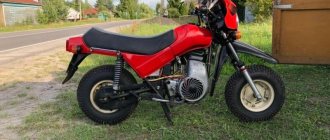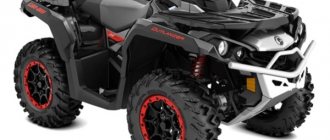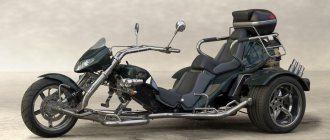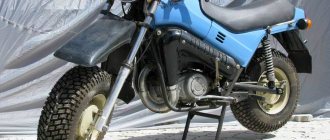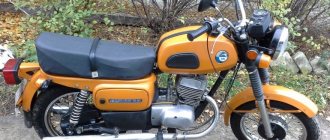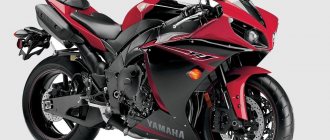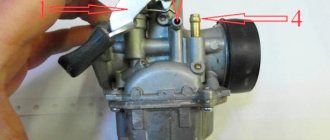What is meant by a classic moped?
According to Russian traffic regulations, a moped is understood as a three- or two-wheeled transport vehicle on which a small engine is installed. The speed it develops is up to fifty kilometers per hour . This is usually a 50 cm3 engine (definitions may vary in other countries). Unlike motorcycles, mopeds do not require registration, insurance, technical inspection, or a driving license. Due to their low speed, they, like bicycles, should move closer to the right side of the road.
The classic type of mopeds is a bicycle drive (pedal), a chain drive to the rear wheel, a freewheel, a brake that is activated when the pedals are rotated in the opposite direction (like a bicycle). The rear wheel also has a driven sprocket for the motor chain drive (rigid, without a freewheel).
Classic moped with pedals
The drive sprocket is located with the engine on the same shaft or (sometimes) separated from the latter by a friction clutch (clutch). To disengage the clutch there is a special lever on the left handlebar. There is no gearbox, but sometimes a gearbox is installed. Rotating the throttle on the right handlebar controls the carburetor valve (throttle). The front brake lever is also located there.
Scooter tuning - accelerating the moped to full power
In recent years, scooters have become increasingly popular among lovers of two-wheeled vehicles. Tuning in this case can be divided into two stages: modifying the engine to increase its power and adjusting the transmission elements to the changed engine parameters. Some owners also carry out external tuning of the scooter, for which they purchase original accessories.
Classification of motors and modernization options Today, scooters are produced with several types of motors. The most popular version of a small cc engine is the Chinese model 139qmb with a displacement of 49.6 cc. Next comes the 153QM model with a volume of 150 cm3 and the 157QMJ with a volume of 150 cm3. Thus, within each type of Chinese motor, the main engine parts are in principle interchangeable. This means that finding parts becomes an easy task.
Previously, the most popular scooter tuning kits were “whales” from Italian manufacturers Pallinni, Mallossi or Metrakit. These tuning kits, as a rule, include a huge range of parts, accessories and equipment for tuning scooters from well-known European, Japanese and Chinese manufacturers. However, in the case of Chinese-made mopeds, tuning with the help of European “whales” is too expensive for ordinary motorcyclists, and there are more and more Chinese scooters on our roads every year.
Today, tuning a scooter mainly comes down to increasing the engine capacity. The most tuned engines are 139qmb engines with a volume of up to 50cc. For example, instead of a standard piston and cylinder of 39 millimeters, wider analogues with a piston diameter of 44 to 50 millimeters are installed. In contrast to European and Japanese-made models, tuning of the “Chinese” mainly comes down to an increase in cubic capacity, as a result of an increase in engine power and the need for appropriate adjustment of the variator and other parts. And if with a 44 mm piston you can leave the factory cylinder head, then when replacing the 39 with a 52 mm version, you will have to change the cylinder head and recalibrate the carburetor. Thus, the easiest way to increase the cubic capacity for a 139qmb engine is to install a 44 mm piston, and you will also need to purchase additional gaskets. As for the larger Chinese-made engines (157QMJ and 153QM for 150 cm3), they are built on an identical platform and externally differ from the 139qmb model only in their longer length.
Removing the speed limiter “plug” The first thing that specialists and tuning enthusiasts do on scooters of various manufacturers is to remove the speed limit “stub”, which prevents the maximum use of the engine resource. As a rule, a scooter can be muffled in several ways: either a plug installed in the variator, or an electronic limiter on the switch, or a special limit washer in the scooter's carburetor.
In the first case, the limiter is a plate that is screwed to the variator from the side of the weights. Due to the installation of this plate, the radiator belt cannot reach its maximum radius while driving. To remove the plug, you need to partially disassemble the variator, remove the belt and gear, carefully remove the restrictor ring and assemble all the parts in the reverse order.
On some models there may be a missing ring, then it is advisable to disassemble the inner “cheek” of the variator and look for the plate there. Sometimes the limiter in the variator is the bushing itself, which has a small protrusion. Accordingly, it will not be possible to remove it; you will have to either bore the part from a familiar turner or a service center, or purchase a new original bushing.
If the limiter is installed in the carburetor, then it looks like a valve, which, in the event of an increase in pressure, blocks the flow of the fuel mixture into the mixing chamber with air. On modern Japanese scooters, the choke is installed in two places on the muffler. To find the plug and get rid of it, you need to look at the muffler and see at the very beginning a double branch, one of the channels of which goes to a dead end. This branching creates excessive circulation of gases, so it must be removed.
And finally, an equally common place to install the limiter is the switch. On Italian scooters, to remove it you need to cut the blue wire going to the switch. If we are dealing with the “Japanese”, then most likely we will have to change the switch to a tuned version. On Chinese models, the plug is the speed reader and the washer on the clutch of the 139qmb engine; the problem can be solved by disconnecting the wire from the reader using wire cutters.
Features of improving the carburetor, cylinder head and variator After disconnecting the plugs, you need to proceed to the next tuning steps. To begin with, it is recommended to replace the factory muffler with an improved version with a resonator. Well-known models include Laser X, Technical Next or Leovince. After installing the new pipe, the transmission must be properly adjusted. Such changes will increase the maximum speed by 7-10 kilometers per hour and improve acceleration dynamics.
Next, you should install a new carburetor with an increased diffuser diameter. For models of Chinese mopeds with a cubic capacity of up to 150 cm3, it is best to purchase carburetors with a stroke diameter of 17.5-20.5 millimeters. Which manufacturer to choose is up to the owner to decide, but some experts advise purchasing models of inexpensive and fairly reliable carburetors produced by DellOrto. When carrying out all of the above work, it is also recommended to install a tuned variator; it will be easier to adjust it yourself to new parameters, since it has a more advanced structure. You can choose models from the Italian manufacturer Polini, which are equipped with a special lubrication system for the main rod.
But the most effective way to really increase the power of a small-capacity scooter is to install a new cylinder-piston group of increased volume. It is important to remember that if you are tuning a scooter with the installation of an improved piston group, it is strongly recommended to check the degree of wear of the crankshaft and bearings, since if they are in poor condition, tuning will completely “kill” them after 1000-2000 kilometers with new parameters. This is where many people who want to tune their scooter stop, especially when it comes to an engine like 139qmb. Further actions can be attributed to racing tuning, and in terms of costs and volume of work they are comparable to purchasing a new, more powerful and voluminous scooter with 150 or 225 cc with sports characteristics.
Another technical tuning option is installing a carburetor enricher. In essence, it is a small additional carburetor that is connected to the main one through three exhaust channels. Sometimes this part is called an automatic starting enrichment. In addition, “racing” tuning of mopeds involves installing a reinforced crankshaft, connecting rod and replacing factory bearings. Only such changes can withstand the new loads that will appear with an increase in engine power.
Removing CPG elements for replacement The first step is to remove the plastic engine protection. Next, disconnect the carburetor from the pipes. After this, unscrew the fastening bolts on the exhaust pipe. At this stage it is also worth removing the muffler by removing the mounting bolts on the inlet pipe and the oil filler neck. After this, it is recommended to clean the joints of the cylinder head and cover from dirt.
Next, using a 10mm wrench, loosen the bolts that secure the cylinder block cover. Removing the cover, you will see the gas distribution mechanism. Using the same key, you need to disconnect the timing belt mounting bolts and carefully remove the mounting bracket, while holding the timing mechanism and sprocket. Before removing the sprocket and chain from the scooter, it is necessary to use copper wire to mark the engagement point of the chain tooth in order to later put it on the same place, although in some cases it is necessary to change the position of the chain after installing the extended pistons.
Next, you need to unscrew the two cylinder mounting bolts and carefully remove the cylinder head first, shaking the mechanism from side to side, and then the cylinder itself. The deposits that are formed in the inside of the cylinder can be cleaned with a solvent, being careful not to touch the valves, so as not to lead to their depressurization. Next, we remove the connecting rod along with the piston, which can now also be cleaned of carbon deposits using a solvent.
To remove the piston from the connecting rod, you need to bend the retaining ring using pliers, then place the rings on a flat surface, they should be perfectly flat, if necessary, trim them manually with pliers. After removing the two retaining rings, carefully squeeze out the piston pin without damaging the latter. Now you can install parts from the tuning kit in place of the old parts.
Adjusting valve clearances Tuning specialists recommend doing the procedure for adjusting valve clearances on mopeds with your own hands every 2000–3000 kilometers. This will improve engine dynamics and avoid the unpleasant “clatter” that comes from the main center while driving due to improper adjustment. Most often, tuning is done on new scooters immediately after the engine has been run-in. Due to overtightened valves, malfunctions are possible when operating at high speeds and speeds above 80 kilometers per hour, especially for 150cc scooters.
Do-it-yourself tuning work is carried out on a completely cooled engine using a screwdriver and 8.9 keys. The first step is to remove the plastic cylinder head cover. Next, unscrew the two screws that hold the valve cover. Once the protection is removed, it is necessary to set the piston to the highest possible position; this may require dismantling the generator fan protection. Next, the valve clearances are checked using a 0.5–0.7 millimeter feeler gauge. The topmost intake valve is checked first; if adjusted correctly, the feeler gauge will fit into the hole between the valve and the adjusting bolt with little difficulty.
To change the gap, you need to slightly loosen the position of the lock nut, after which you need to rotate the adjusting bolt counterclockwise and, without removing the force, tighten the fastening nut again. After this, the gap will change, and you can determine the degree of change using the same 0.5 millimeter feeler gauge. The same steps must be repeated with the bottom valve and install the generator protection and the plastic main housing casing in the reverse order.
Gas moped
A moped, due to the absence of gear shifting, in which the speed is controlled only by the “gas” handle, is called a gas moped. Another name for them is motorbike , although the name comes from “motorcycle” and “bicycle” (pedal). The designs of mopeds produced today are much more complex.
Despite the presence of pedals, it is almost impossible to ride mopeds without a motor. The design is much heavier than a traditional bicycle, and the low seat is suitable for motorized riding only.
Video: Original gas moped
How to install HBO on a motorcycle or scooter?
If possible difficulties do not bother the owners of motor vehicles, it is worth understanding in detail the issues of installing gas equipment on a two-wheeled vehicle. Due to the fact that specialized centers do not carry out such work, you will have to convert the moped to gas yourself. Let's figure out what is included in the gas equipment kit for a motorcycle and how installation is carried out. Let us also dwell on the features of the functioning of the gas cylinder system.
Gas moped - elements of a gas installation
For tuning, you need to prepare a set of equipment, including the following parts:
- a gas cylinder with a capacity of at least 6 liters, the dimensions of which correspond to the free space on a moped or motorcycle;
- a set of fittings for connecting to the intake manifold, gearbox and connecting lines with coolant;
- a reducer designed to reduce the pressure of liquefied gas and convert it into a gaseous state;
- a control unit that has a built-in chip, the firmware of which provides control commands when the engine is running on gas;
- pressure and temperature control sensors with electrical wires equipped with connecting connectors;
- a collapsible liquefied gas filter that cleans the fuel from foreign impurities and allows you to replace the cartridge.
A set of equipment must be prepared for tuning a moped with a gas installation.
You will also need a button with which you can forcibly turn the gas on and off. The equipment set includes adjustment elements, a safety valve, a ramp and a number of other parts indicated on the typical connection diagram for a gas cylinder installation.
Installation
Having prepared everything necessary, they begin installation work in accordance with the chosen scheme. Before you start tuning, you should clearly determine where the elements of the gas cylinder installation will be located, how the lines will be laid to ensure their safe operation and maintenance.
First, you need to securely secure the gas cylinder in the case or seat box and connect the injector emulator to the scooter control unit. Then you should place a gas supply button on the dashboard. The further procedure involves connecting sensors, connecting supply lines to the gearbox, nozzles and cylinder, as well as connecting lines with coolant to the gearbox.
The connection of the control unit is carried out in strict accordance with the previously prepared circuit diagram of the electrical equipment. It is advisable to use wires of different colors to avoid installation errors and to correctly connect all electrical equipment. After completing the installation operations, it is necessary to check the tightness of the fuel lines and make sure that the controller and emulator are connected correctly.
You can do the installation of a gas installation on a scooter yourself
Leakage control is carried out by spraying a soap solution onto the fittings connecting the fuel pipes to the injectors, gearbox, ramp and gas cylinder. If bubbles form, it is necessary to tighten the fittings more tightly to prevent leaks of liquefied gas.
Gas motorcycle - operating principle
The operation of the gas cylinder installation is quite simple. When a control signal is applied to the multivalve of a gas cylinder, propane-butane under pressure enters the reducer through the intermediate valve.
The transformation of liquefied fuel into a gaseous state occurs as a result of heating of the gearbox by the liquid circulating in the cooling system. The reducer regulates the pressure of gaseous fuel directed to the injectors in proportion to the vacuum in the intake manifold.
Information from the temperature sensor and gas pressure sensor built into the manifold is sent to the controller, which also processes information about the crankshaft speed. Working in tandem with the scooter's control unit, the controller decides whether to turn on gasoline or gas injectors and their operating modes.
If the engine does not heat up enough during start-up, the control system turns on the supply of gasoline to warm up the engine. Once the operating temperature is reached, it automatically switches to gas. After the reducer, the gas flows through pipelines to a ramp on which electromagnetically controlled injectors are mounted. The volume of gas entering the combustion chamber depends on the cross-section of the outlet fittings. Depending on the engine cubic capacity, the channel diameter should be 1-1.5 mm.
For long mileage, it is advantageous to equip motorcycles with gas equipment.
An engine with an injection power system needs one more component - an emulator. It is included in the system in parallel with the injectors. When switching from gasoline to gaseous fuel, the gasoline injectors are switched off. However, the emulator simulates their functioning so that the control unit does not turn off the power system.
pros
Another advantage is that gas is slightly cheaper than traditional fuel - gasoline. In addition, gasoline poses a risk of inhaling harmful substances contained in it, such as ferocene or tetraethyl lead, the inhalation of which leads to dire consequences.
These representatives of the chemical industry are absent from gas, just as tar deposits are not formed during its combustion. This can be judged by the color of the engine oil, which remains almost unchanged. When running on gasoline, it turns black.
The feasibility of installing HBO
The question may arise about the advisability of installing a gas cylinder system on a motorcycle or scooter, because modern scooters already have fairly low gas mileage. When consuming 2-2.5, maximum 3 liters of gasoline per hundred, is it worth incurring significant costs and installing gas equipment? The answer is clear - it’s worth it, for those who want to modernize their two-wheeled friend.
A drop in power and an increase in fuel consumption is one of the negative aspects of a gas-cylinder installation
However, for those who travel little and use a scooter only as weekend transport, the costs will not pay off very quickly. At the same time, if you need to travel long distances to work every day, such a modification will allow you to save significantly.
One of the negative aspects is a drop in power and increased fuel consumption. When the engine runs on gasoline, it enters the engine in a liquid consistency, occupying a reduced volume compared to gas.
A smaller amount of gas entering the engine cylinder through the carburetor or injector causes a drop in thrust. The engine needs more gas fuel, which causes an increase in its consumption by 8-10% compared to gasoline.
Finding a place for a gas cylinder is also a serious problem. The volume of the seat box, in which a helmet is usually stored, does not always allow for a gas cylinder to be placed. It is not possible to equip a moped or motorcycle with a standard car cylinder. Today, small-sized fuel tanks for gas with a volume of about six liters are offered. The volume of the rear case, which will have to be additionally equipped with the motorcycle, will allow you to accommodate a six-liter container.
It is necessary to dwell separately on the design features of the scooter, which is planned to be equipped with gas equipment. For such a modification, the moped must be equipped with a four-stroke engine and be able to start with a kickstarter. There is a high probability that using the electric starter for a long time when starting the engine on gas will drain the battery much faster.
Finding a place for a gas cylinder is a serious problem
As you can see, converting a scooter, moped or motorcycle to gas has not only positive aspects, but also negative aspects. However, this does not stop tuning lovers. They have to independently equip their motorcycles with a cylinder, install gas lines and install dosing equipment, since there are no specialized service centers involved in gasification of mopeds and scooters.




